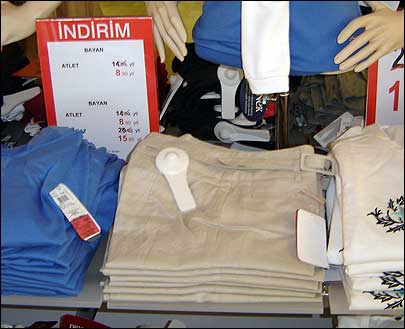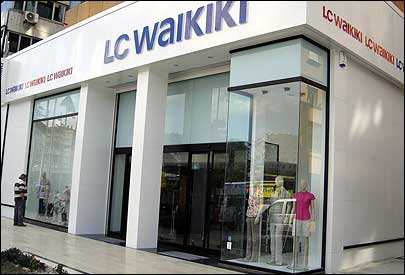Aug 15, 2008LC Waikiki, a Turkish retailer owned by apparel manufacturing company Taha Group, is employing a combination of radio frequency identification and acousto-magnetic electronic article surveillance (EAS) technology to manage inventory, replenish stock and prevent theft.
The system, designed by Turkish RFID systems integrator STS Technology, hinges on the Sarfid Hard Tag, developed by STS, which consists of Alien Technology's ALN-9540 or ALN-9562 Squiggle EPC Gen 2 RFID inlay and a 58 kHz acousto-magnetic EAS tag embedded in a thick plastic case. The deployment also includes handheld and fixed RFID interrogators, EAS portals and software integrated with the retailer's inventory-management and point-of-sale systems.

After several months of planning and design, the technology was first implemented about nine months ago in LC Waikiki's flagship store in Istanbul, and was recently expanded to another location in the Turkish city. The retailer is also installing the system in two additional stores, says Stephen Crocker, Alien's director of sales and channels for Europe, the Middle East, Africa and India, and hopes to have it installed in 50 of its 180 stores around the country within the next six months.
LC Waikiki does not sell its men's, women's and children's clothing through department stores; instead, it operates small shops typically spanning about 2,000 to 4,000 square feet. But the shop size belies the company's business acumen.
"LC Waikiki has grown tremendously as a company, and they are a very IT-savvy company," Crocker says. "Most retailers know they have shrinkage problems, but LC Waikiki wanted to do more than just fix that. They wanted to control inventory. They wanted to have just-in-time inventory, and they wanted it to be the right inventory. EAS would have worked fine if all they wanted were a system for security. But RFID was really the right fit."
Prior to implementing the RFID-EAS system, LC Waikiki managed its inventory manually, typically by scanning bar-coded labels on the clothing. The new system in the flagship store is used to track and manage more than 20,000 clothing items, ranging from men's shirts to children's socks. The system in the second location, which went live on the first of this month, monitors more than 50,000 items.
When clothing is received from the distribution center, employees utilize an ATID PDA with a built-in bar-code scanner and RFID interrogator to scan the bar-coded label placed on each item at the point of manufacture. At that time, the employees also attach the combination EAS-RFID tags, which measure approximately 4 inches in length and 1.5 inches in width, and are 0.25 inch thick. The workers use a separate desktop reader developed by STS, the SARFID 500, to encode the tags' RFID inlays. The SARFID system software marries the item's bar-coded number with the unique ID encoded on the RFID inlay, then updates the inventory management system.
When an item is purchased, an RFID interrogator positioned beneath the sales counter reads the tag's RFID inlay, and the inventory is updated once more in real time. The sales clerk then removes the EAS-RFID tag for later reuse on another garment. If a person were to attempt to take an item out of the shop with the EAS-RFID tag still attached to it, an EAS portal at the front door would detect the tag's EAS component and sound an alarm. Simultaneously, an Alien ALR-8800 RFID interrogator deployed at the door would identify the items being stolen.
Since implementing the system at the flagship store, LC Waikiki has seen tremendous improvement in its stocktaking and in-store inventory replenishment processes. In fact, the retailer reports, the time required to move stock from the back room to the sales floor has been cut by 70 percent.
In the past, the staff employed a handheld device to scan the bar-coded labels of goods moving from the back room to the front of the store, a process that took 1 minute 52 seconds for 50 items. With the RFID system, it now takes only 7 seconds, because the items are automatically identified as they are removed from the cabinet and placed into the bin.
In addition, LC Waikiki indicates, the time needed to inventory the entire store has been reduced by 60 percent. It used to take 14 employees five hours to conduct such an inventory, says Levent Yalcinkaya, a manager with STS, whereas it now takes one person 50 minutes. "And there is more reliable data for the decision makers sitting at headquarters," Yalcinkaya states.
In addition to continuing to roll out the EAS-RFID system to all of its stores, LC Waikiki may consider other applications as well. "Smart shelves will be the next attractive and valuable investment for our customer," he says.


